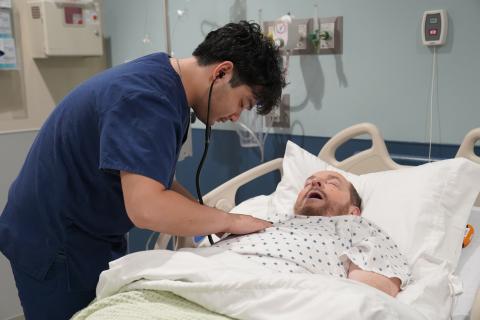UNH Nursing Simulation Brings Realism to End-of-Life Care Training

Undergraduate nursing students at UNH recently had the unique opportunity to participate in an end-of-life care simulation involving a professional actor portraying a dying patient.
The simulation was led by Charles Adler ’16, ’G17, as part of an independent study he completed through the Family Nurse Practitioner (FNP) program, as well as in his role as a graduate assistant supporting undergraduate students.
Offered as a make-up opportunity for clinical hours or as extra credit, the simulation drew more than 40 student participants across three sessions.
The scenario featured a 75-year-old man who had suffered a devastating stroke. An actor lay in bed playing the role of the unresponsive patient, while an acute care nurse practitioner delivered difficult news to the patient’s daughter—played by another actor.
"I tried to simulate the realism as much as possible with getting real actors and setting it up as realistic as I could from my own memory and experience of working with these patients,” Adler says. "There was no sugarcoating what that looks like. It was pretty spot on."
In one scenario, two nursing students observed as the practitioner discussed the patient’s prognosis and introduced the topic of Do Not Resuscitate (DNR) orders with the daughter. Once the DNR decision was made, the practitioner left the room, and students were tasked with answering follow-up questions and offering emotional support. They were also asked to perform basic care, such as turning the patient to prevent pressure ulcers.
In the second scenario, students remained in the room during the patient’s final moments.

Each session included extended pre-briefing and debriefing periods, giving students the chance to ask questions, reflect on their performance, and receive feedback in a supportive environment.
Adler says his goal was to provide a safe space for students to experience emotionally complex scenarios without the pressure of having to get everything right the first time.
“I wanted to create a really challenging simulation, but with all the supports in place so that they didn't feel like they were out of their scope of what they were able to accomplish. And they had support in the moment,” Adler says.
Adler hopes to expand the simulation in the future, possibly integrating other disciplines such as social work, chaplaincy, and UNH’s acute care nurse practitioner program to build a more interdisciplinary learning experience.
"I love this type of work because it speaks to the art that is nursing and not so much the science piece of nursing...death is the most universal, certain experience there is,” Adler says. “If I can get more nursing students to be comfortable or approach death and dying in a different way to support families, that is always the goal for me.”
Adler also reminded students that while the simulation focused on death and dying, that’s only one component of palliative care. He emphasized that the field includes many rewarding and significant opportunities to support patients and families through serious illness and improve their quality of life.
